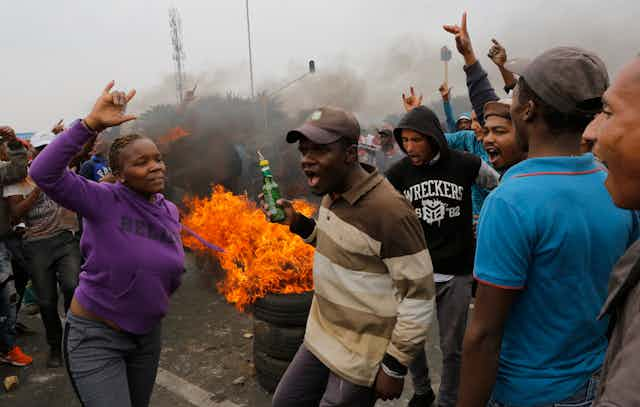Recent violent protests in South Africa have refocused attention on the growing number of demonstrations over government failure to provide basic services, such as water and electricity. The country is known as the “protest capital of the world”.
Research by the Centre for Social Change, University of Johannesburg seems to bear this out. Based on estimates from South African Police Service data, we found that between 1997 and 2013 there were an average of 900 community protests a year. In recent years the number has climbed to as high as 2,000 protests a year.
The situation in South Africa is not unique. Protests have been increasing globally, particularly since the 2008 global economic crisis.
In a new book, my colleagues from the Centre for Social Change and I attempt to understand South Africa as part of the global protest wave.
On the face of it, protests in South Africa look quite different. They tend to be fragmented and happen mostly in black townships and informal settlements. The occupation of central public spaces in towns and cities, as we are seeing in Venezuela, happens seldom.
While there are important differences there are also commonalities. Whether protests focus around the “1%” as they did during the Occupy movement or around the lack of service provision in townships, protesters around the world are critiquing the failure of a representative democracy to provide socio-economic equality.
Broken promises
South Africa’s governing ANC came into power in 1994 on the promise of a “better life for all”. There have been important gains, such as increasing access to electricity from 51% of the population in 1994 to 85% in 2012, but inequality remains endemic. Recent data from the World Bank confirms that South Africa remains one of the most unequal countries in the world.
As part of research by the Centre for Social Change we spoke to protesters all over the country. A new book from the centre highlights the extent to which protesters are raising not just concerns about the quality of service delivery but also about the quality of post-apartheid democracy. As Shirley Zwane, from Khayelitsha, near Cape Town, explains:
We don’t have democracy!… We [are] still struggling… you see if we are in democracy there’s no more shacks here… No more bucket system… we supposed to have roads, everything! A better education… There is a democracy?…. No, this is not a democracy! They have, these people in Constantia, Tableview, Parklands, they have a democracy, not for us!
For Shirley the quality of post-apartheid democracy is linked to the provision of basic services. She is not alone in this view.
Research by Afrobarometer has found that compared to other countries in the region South Africans are much more likely to emphasise the realisation of socio-economic outcomes as crucial to democracy. That South Africans should view housing and services as central to post-apartheid democracy is unsurprising given that apartheid systemically denied the majority of people these rights.
Crisis of affordability
Community protests are fundamentally about the exclusion from democracy experienced by many black working class citizens since the end of apartheid in 1994.
Although the provision of services to the previously marginalised black majority has increased substantially, black working class households face an increasing crisis of affordability.
In sectors covered by a minimum wage, the real median wage increased by 7.5% between 2011 and 2015. But last year inflation on an average working class food basket was 15% and certain staple foods, such as maize meal, increased by as much as 32%. This has put a real squeeze on working class households especially when, due to high levels unemployment, each black South African wage earner supports four people.
Structural challenges
The crisis of affordability facing black working class households also compounds the structural crisis within local government.
In South Africa local governments are responsible for delivering services. Over the past 15 years local municipalities have increasingly had to find ways to fund these services through their own tax base. Many have resorted to cost recovery measures, for example by introducing prepaid meters. Their introduction has been behind many protests.
The financial difficulties for local and provincial governments looks set to get worse. In the country’s latest budget the National Treasury cut their funding as part of R25 billion budget cuts. In the case of Gauteng, the scene of the most recent protests, this amounted to a R2.9 billion rand cut over three years.
To fill the gap, municipalities and provinces are going to have to look increasingly to their own tax base to fund service provision. A difficult prospect when slightly more than half the population survives on R779 or less a person a month.
A global crisis
As Professor Michael Burawoy argues in our new book, the nature of the crisis varies from country to country. In South Africa the crisis represents the forcible exclusion of many black working class households from democratic institutions, largely because of their inability to afford socio-economic goods. For instance, while access to electricity has increased, access is increasingly mediated by prepaid meters, therefore the ability to access service is inextricably linked to the ability to afford them.
It’s this exclusion that leads many to say that democracy is only for the rich. Globally, people are beginning to search for new solutions to these problems with many being drawn to left-wing movements and political parties, such as Podemos in Spain. Whether such a comparable movement can emerge in South Africa remains to be seen.

